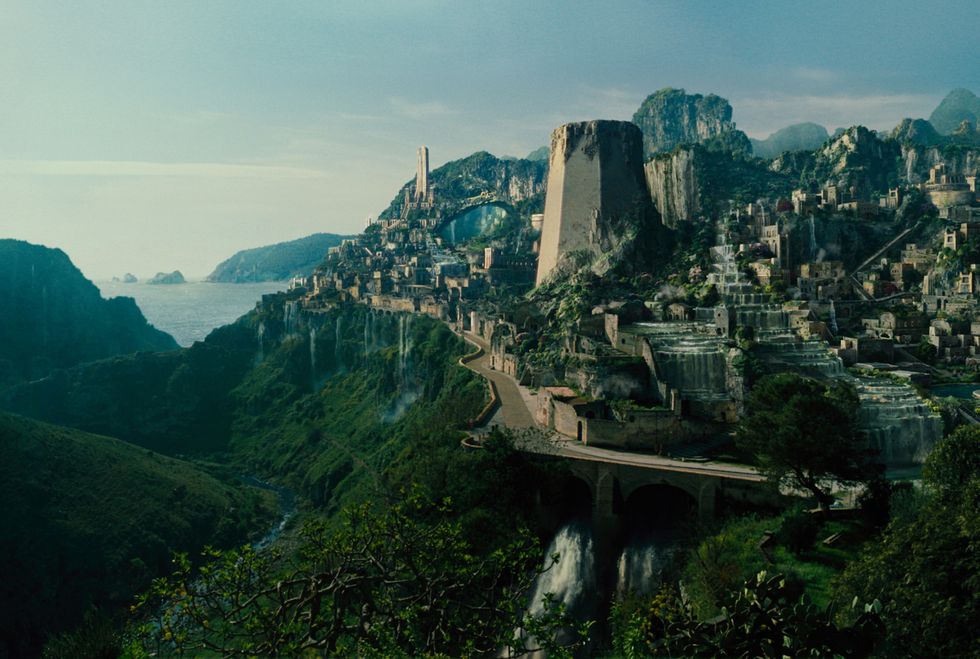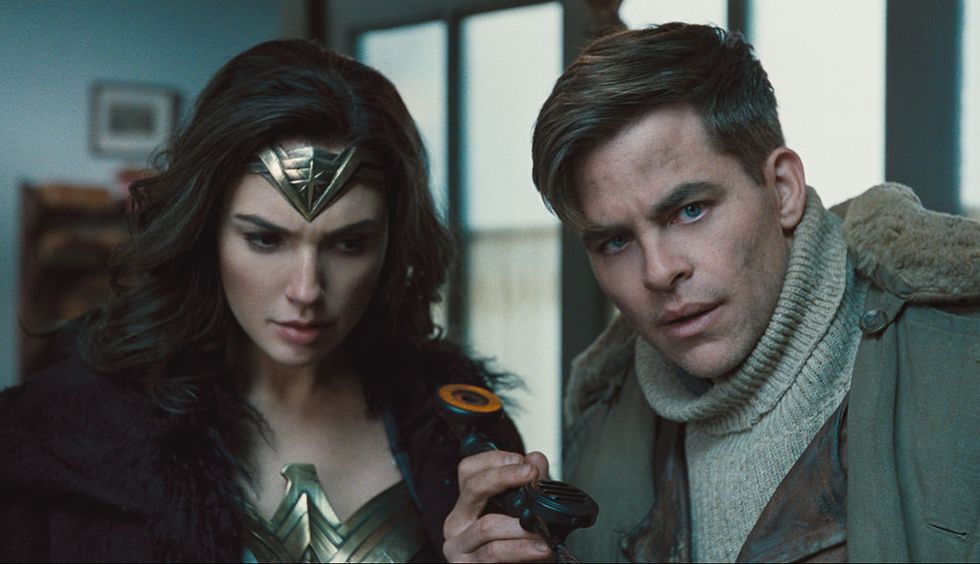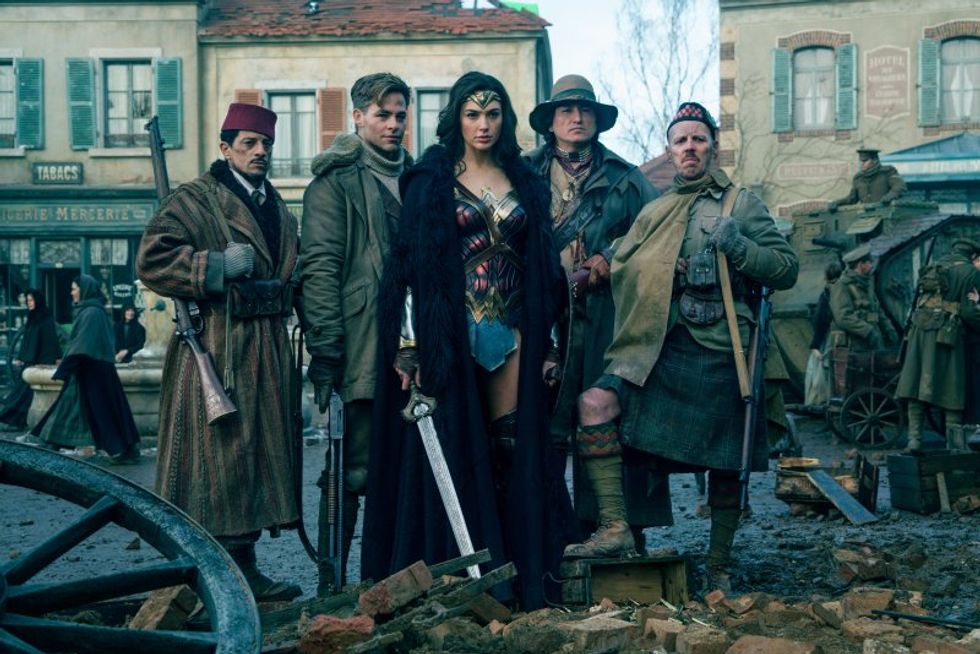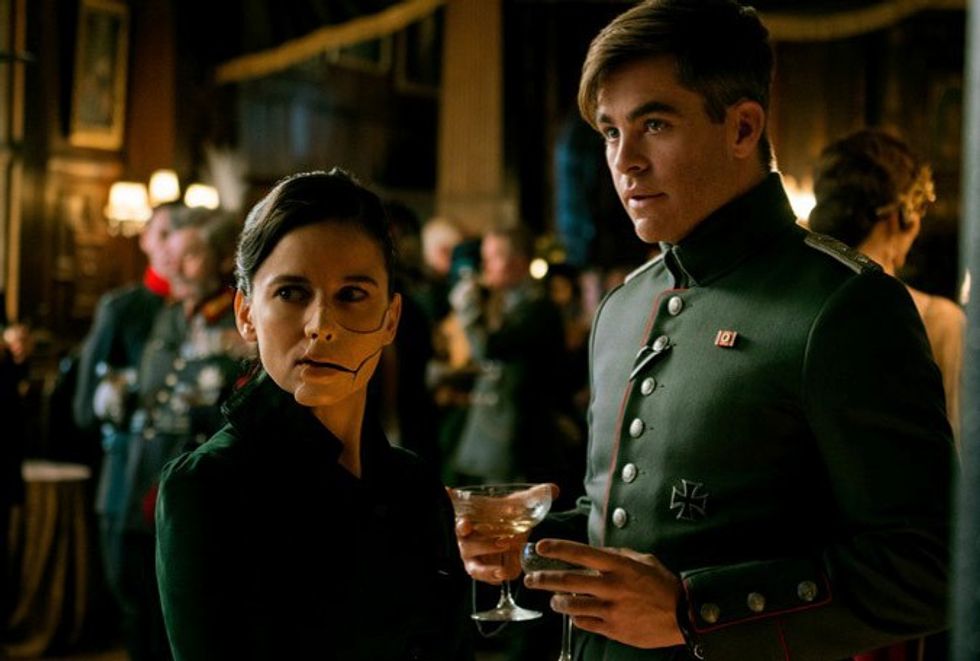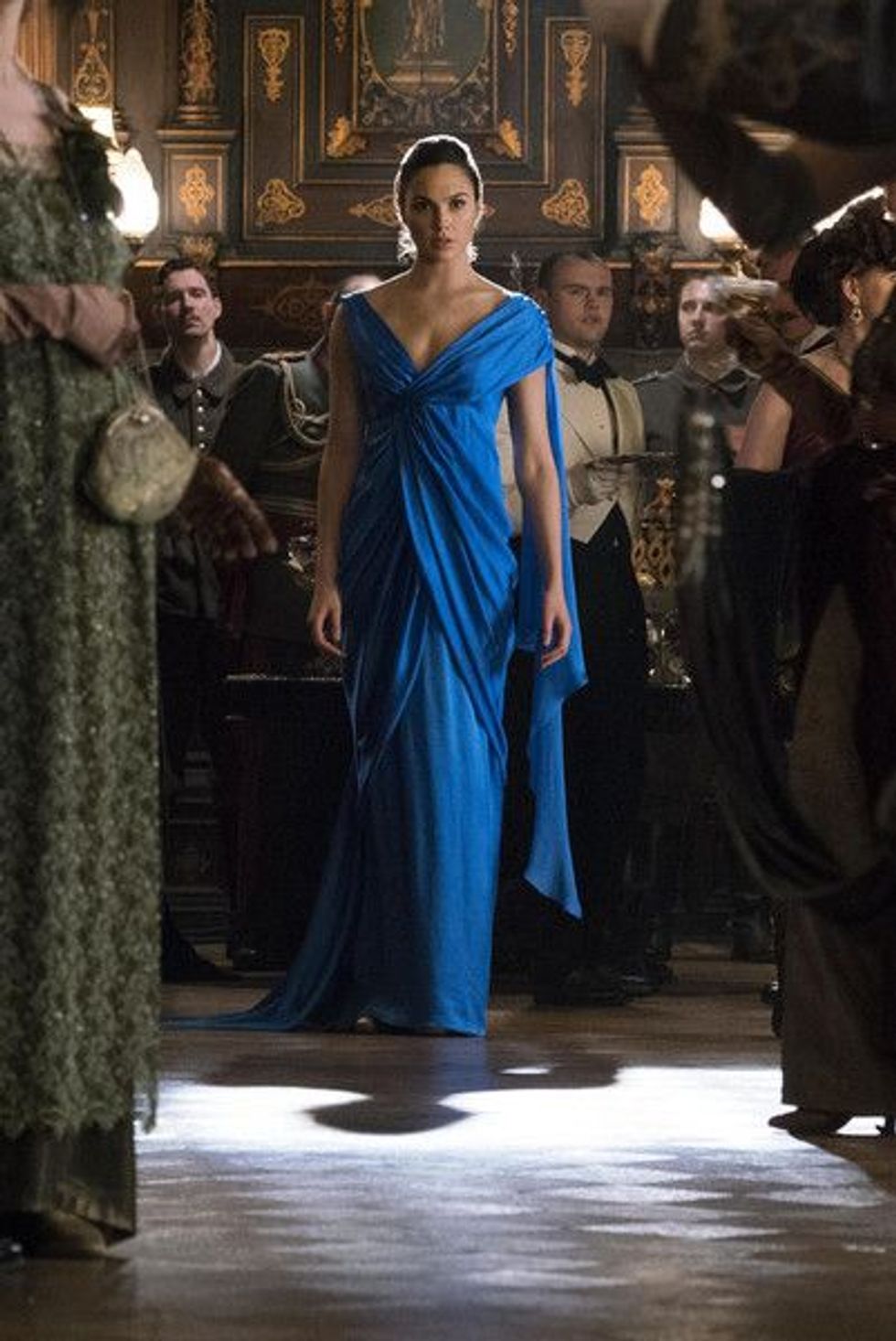I’m going to write this the night after seeing it, since there were definitely things that I didn’t like about the movie, and if I wait to review it, those simmering dislikes will probably overshadow all the good things that I enjoyed. Especially since I conceded SO MUCH to "Batman V. Superman," which is far and away one of the laziest movies ever, it would be unfair not to gush about what "Wonder Woman" got right. So here’s the good parts first:
The first 20 minutes, and the Amazons
The island stronghold of Themyscira was easily the best-designed, most beautiful locale of the movie, and it was actually saddening when the characters left. The buildings hid in lush vines, and the shallow sea was a perfect Aegean blue.
It’s also quite a while before we meet the first man. I’ve read bits of the scrapped Joss Whedon screenplay for this movie, and all I can say is thank God they didn’t use it. Whedon’s plot begins with the male character, Steve, and barely depicts the Amazons as they exist in their own society. The final version of the screenplay gives us lots of time to grow up with Diana in a completely female environment. In particular, there’s a scene in which the child version of Diana watches the adult Amazons training to fight, and I teared up watching it. The fight choreography, the shots of women riding horses, the Amazons dropping from the saddle mid-ride to retrieve their fallen shields, their bodies glorified not for their sexual attributes but for their skill and power – it wasn’t until I saw it that I realized that I had never watched anything like it in a live-action movie. Not for that long.
This moment that the male body has enjoyed since ancient Greece is very noticeably given to the female body here. Given the Greek mythological elements of the island, I almost wanted to think of it as a parallel ancient Greece where the female form, instead of being softened and made to demurely half-cover its breasts, finally gets to throw its own discuses and hurl its own spears.
Choreography
All the fight sequences in this film are astounding, and they understand combat as a poetry of the body in ways that modern superhero movies really don’t anymore. It has more in common with Ben Hur and Greek/baroque sculpture than Batman V. Superman. Believe me when I say that this movie is worth seeing in theatres if only for the scene of Wonder Woman crossing No Man’s Land between two World War One trenches and singlehandedly besieging a town. They show cool parts of this during the trailer, but thankfully the actual sequence has even more amazing visuals.
Gal Gadot and Chris Pine
Both are very well-cast, and have a really great chemistry. I’m very happy that their romantic relationship could be written in such a way as to not reduce Wonder Woman to a simpering – I don’t know – vestal virgin or Miranda-from-The Tempest-who-has-never-seen-a-man-before.
Representation/Supporting Characters
I wasn’t sure how I felt when, on top of a Moroccan (? He wore a fez) con man named Sameer, the characters teamed up with a Native American (I didn’t catch which nation he belonged to, if they covered it) smuggler named Chief. Sameer was hilarious, and I really enjoyed every moment he was onscreen (he was a bit of a smooth-talking ladies’ man, but not an Orientalist’s Lothario), and I should honestly defer to Native viewers on Chief. He seemed like a very kind, generous guy – he smuggles Edgar Rice Burroughs novels to both sides – and the film did address his alienation from his home country because of its genocidal practices. I just felt like the script gave me an incomplete understanding of who he was.
Less central but still cool: a scene set in a major train station in London did a fantastic job of showing the global participants of the British war effort; from a Sikh force to a group of nuns working as nurses.
WEAKNESSES:
History/Details
I’m a nerd, but I’m pretty sure that even the noobs in the audience were wondering how Wonder Woman, if her people were confined to their isolated island since the Bronze Age, knows what “sulfur” and “hydrogen” are, much less HOW TO READ THESE WORDS IN ARABIC SCRIPT, which didn’t arise until the 4th-5th centuries CE. Or how she could speak English, which wouldn’t appear until even later. And just a million other small things, like Diana’s surprising lack of concern when other characters mention that women can’t vote or that the American government exploits and oppresses Chief’s people.
“Above Average”
I mean, all legs being as thin as necks
When Diana accidentally sees him naked from the waist down, Chris Pine’s character jokes that he’s “above average” in size, which is fine. But for the rest of the movie, I found myself attributing this to all of the Amazons onscreen. Are they strong, fit, and athletic? Yes. But I would definitely call each and every one of them a size 0 to 2. At most, a very skinny 4, and 4 only because of height. Leading up to the film’s release, the film took a lot of flak for casting Gadot, a slim model/actress and Miss Israel, as Wonder Woman, which seemed unwarranted at the time considering the amount of effort she put into training for the role. But looking at the rest of the Amazons, I can’t help but wonder if the criticism is deserved. If the film showed Amazons of different body types, it would have been all right: I’m thinking of the differences in distance runners, sprinters, pole vaulters, and shot putters that you can see on any track team. But by opting to cast all beautiful, Instagram-ready, perfectly made-up women as the Amazons, I’m worried this movie reflects the popular (erroneous) belief that if a woman – any woman – just exercises and trains hard enough, she can “change her body” to have a size 2 physique, as if a size 2 represented peak health and physical ability. This is not true, and Hollywood really needs to work this out of its subconscious.
Dr. Maru (TL;DR Homely=Evil)
This emphasis on statuesque beauty was especially gross when the film compared the ravishing Diana to one of the villains, German-sided chemist and This Film’s Mousy Spinster, Dr. Maru. Normally this stuff just mildly annoys me, but Dr. Maru’s character was so consistently put down by the script in ways that actually resembled how people have treated me in real life that I really can’t let it slide. Her character basically boils down to
1) evil chemist who invents deadly gases to kill mass amounts people in excruciating ways,
2) sexually repressed career woman,
3) unattractive, makes no effort to be attractive,
4) easily manipulated by men, all of whom only pretend to have attraction to her.
Since there’s no personal history given about why she makes the gases, her singleness, alleged homeliness, and cerebral abilities get tangled up and conflated with her evil. It was a bit strange, in a 2017 movie celebrating female independence, to see the only woman character in higher education, the only non-gorgeous woman, the only woman depicted as writing a book (!) being the villain without an explanation. Maru’s villainy comes across as an expression of her deviance, a moral degeneracy that goes along with her physiognomic unattractiveness and intellectual overdevelopment.
Growing up, I heard from family that “you ought to date, and you ought to learn about being with a man, because if you don’t, you’re going to end up so desperate for romantic attention that a guy will be able to walk all over you and you’ll like it.” I highly doubted the veracity of this then, and I highly doubt it now as a young woman, but this is exactly the philosophy that this movie communicates through Maru: it is the natural state of a woman to be dating, to be sexually available; to not be so leads to erraticism and perversion of chracter. Both the German general Ludendorff and Chris Pine/Steve impersonating another German commander use sexual manipulation to control Maru, who – continually flashing “lucky me!” glances, yields to their every demand and melts like putty in their hands.
Long story short, there are two types of virgins in this film. Maru’s effectively a weak, hysterical (in every Galenic sense), old maid who doesn't fit in to the sexual economy: she'd be right at home growling out the sexually-frustrated opening monologue to "Richard III" to justify her gas experiments. In contrast we behold the supple, skin-baring Diana, who rejects Steve's sexual companionship but warms to it eventually. It's Diana who's the it-girl in this movie: she has mastered the art of being the modern woman, tough and beautiful, independent but still sexually available, achieving complete and utter #Flawless. In the scene where Pine tries to seduce Maru, his plan fails when he gets distracted by Diana, entering the ballroom in a seductive blue gown. Maru, hurt, realizes that “your attentions are really elsewhere.” We are, of course, meant to sympathize with Pine, because, really, who would ever want a woman like Maru? This moment is triumphal and primal; it is also a perfume advertisement.
Of course, no one should praise war criminals, and if anyone actually fell in love with a mass murderer I’d be worried. But I wondered at the fact that this movie saw the character of Maru / Dr. Poison and decided that yes, to need to fill the role of a mass poisoner, we need to retcon all previous depictions of Maru as beautiful because yes, a career-driven, plain-looking, introverted woman is exactly the type of character who would become a sadistic evil genius. I was reminded of one high school teacher took it upon himself to tell the whole class I should not be so “dead set in my ways” for wanting a college degree because it was bad for me, and why I was typecast in high school as the frigid, repressed, unpleasant villain. Maybe I understand and over-analyze the cultural attitudes regarding Maru because I literally played her for years.
Dr. Maru, Part II (CW: facial scarring)
While the Amazons, the film’s heroes, are constantly remarked upon as being stunning, Maru – who should be a feared scientist, right? No? Just sexually starved again? – is always characterized as terrifying, probably due to the scarring that she covers with a Phantom-style mask. Later, when the mask is stripped away, the film’s main villain, Ares, tells Wonder Woman that Maru’s face is the true face of mankind: foul, twisted, and ugly. Needless to say, while some of the Amazons have shiny pink scars on arms and legs, Maru is the only character in the film with facial scarring. I do not have facial scars myself, but I do know people who do, and this is just extremely poorly handled. Especially given that face masks after the Great War helped many soldiers scarred by gas to resume normal lives, restore their confidence, and feel like themselves again, to appoint the mask as a symbol of evil in this case seems unnecessarily simplistic. It only contributes to the visual politics of a movie wherein attractive=good, and unattractive=actually evil.
Jesus Imagery
Gal Gadot is a Jewish actress playing a pagan protagonist, so why is she rising from the ashes with her hands on either side and feet straight down in a perfect imitation of Jesus on a crucifix? We don’t know? There’s just a contractually required moment of Jesus symbolism in all superhero movies?




